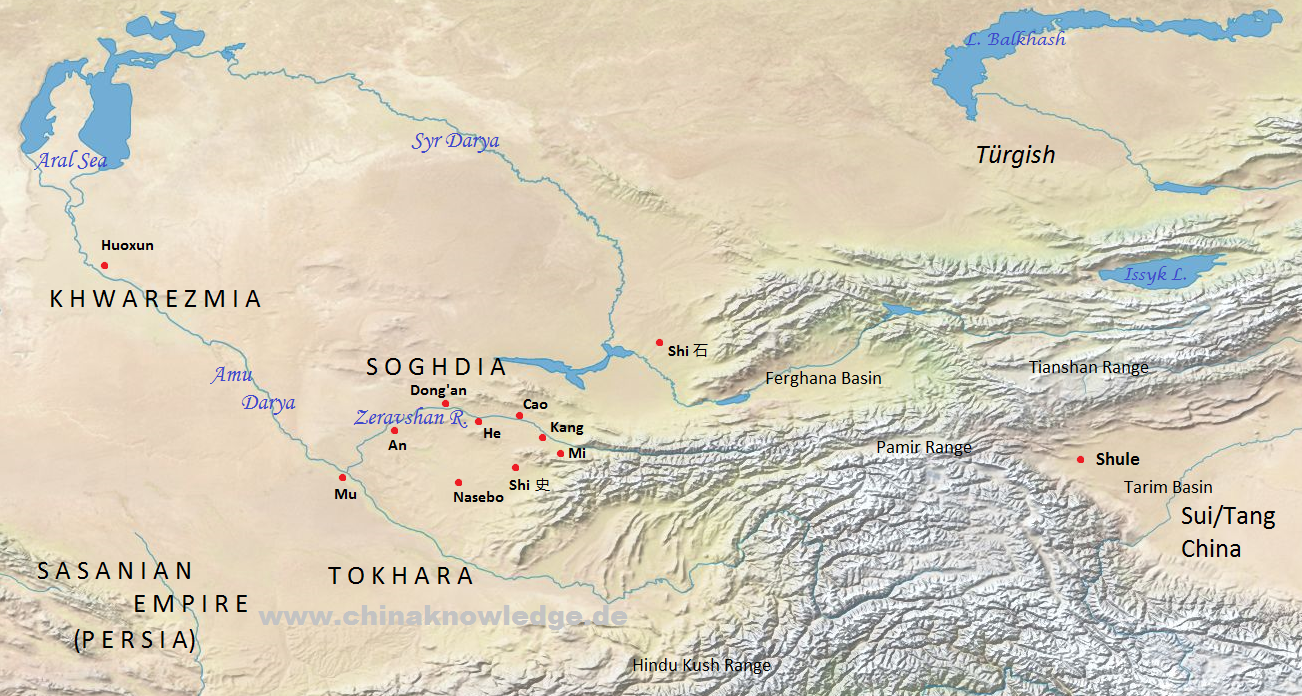The state of Anguo 安國, short for Alanmi 阿濫謐(國), was located in the region of Bukhoro (Bukhara) in modern Uzbekistan, a land formerly known as Soghdia or Soghdiana, in Chinese Sute 粟特. During the Han period 漢 (206 BCE-220 CE) it was called Jiguo 罽國, under the Northern Wei 北魏 (386-534) Niumi 忸蜜, and from the Sui period 隋 (581-618) on Anguo. It was also transcribed as Fuhuo 副貨, Buhua 布豁 or Buhe 捕喝 (a translation of "Bukhoro"). Alanmi is actually the Chinese designation of the capital, which was in the native language called Ramithan. The city was located at the banks of River Nami 那密 (today called Zeravshan, in Chinese Zelafushan 澤拉夫善河, a tributary of the Amu Darya). According to traditional accounts the city was founded by one of the Nine Tribes from Zhaowu (Zhaowu jiuxing 昭武九姓). The state flourished during the sixth century CE.
 |
The Soghdia around 600 CE. Based on Tan Qixiang 譚其驤, ed. (1995), Zhongguo lishi ditu ji 中國歷史地圖集, Vol. 5, Sui, Tang, Wudai Shiguo shiqi 隋唐五代十國時期 (Beijing: Zhongguo ditu chubanshe, 1996). |
According to the official dynastic history Suishu 隋書, its population had moved from the city of Zhaowu 昭武 north of Mt. Qilian 祁連山 (in modern Gansu) into the land of the Yuezhi 月氏 (Tokharians). The city of Anguo was controlled by the state of Kangguo 康國 (former Kangju 康居) and was culturally influenced by various Türkish tribes. The inhabitants of Anguo were famous for the skills in dance and music, and were also active merchants along the Silk Road.
In 609, Anguo send their first tribute mission to the court of the Sui dynasty 隋 (581-618). After their victory of the Western Türkish Khanate, the Tang dynasty 唐 (618-907) established in the country of Anguo an indirectly administered prefecture (jimizhou 羈縻州) called Anxi 安息 (in remembrance of the Parthian empire). Another city in the vicinity, the city state of Dong'an 東安國 "Eastern An" (also called Lesser An 小安國, Hehan 喝捍 or 喝汗, near modern Navoi), the prefecture of Mulu 木鹿 was founded. The region was part of the Chinese imperial Protectorate of the Pacified West (anxi duhufu 安西都護府). In the mid-7th century it was conquered by Muslim invaders.